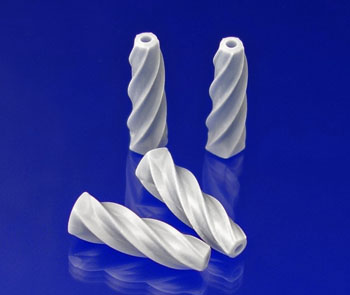Bioceramic Surgical Screw Implants Bond with Bone
By HospiMedica International staff writers
Posted on 08 Nov 2016
A new bioceramic implant screw nail, dubbed a “scrail,” is made of calcium phosphate, which greatly resembles the composition of bone material.Posted on 08 Nov 2016
Developed by researchers at the Fraunhofer Institute for Manufacturing Technology and Advanced Materials (IFAM; Bremen, Germany), University Hospital Giessen-Marburg (Marburg, Germany) and other institutions, the scrail, contrary to medical screws made of titanium or polymer, is not designed be screwed into the bone. Instead, it’s intended to be carefully hammered into place, with a specially shaped thread that involves a minimum number of rotations, thus reducing the risk of damage to tendons and bones.

Image: Bioceramic screw nail implants bond with bone (Photo courtesy of Fraunhofer IFAM).
In contrast to metal components, the ceramic scrail integrates into the bone and does not have to be removed, since the two components – calcium phosphate and hydroxyapatite – are very similar to bone material. The greatest challenge was attaining the maximum strength of the material, since ceramics are fairly breakable. This was solved using injection molding, with hydroxyapatite powder poured into scrail molds and then heated. The procedure is particularly suited to mass production, but can also be used in conjunction with three-dimensional (3D) printers, allowing production of patient-specific implants.
“Ceramic-based screw nails do not disintegrate, but instead bond with the bone. Ideally, they can even accelerate bone growth,” said Sebastian Hein, PhD, of Fraunhofer IFAM. “This is a distinct advantage over polymer screws, which disintegrate in the body. Degradation products from polymer screws can cause inflammation; additionally, after the disintegration of the screws, cavities can form in bones, rendering them unstable and more prone to breaking.”
Implant screws can be used for attachment of implants to bone, bone to bone fixation, soft tissue fixation, or anchorage. They are designed to maximize initial contact and distribute the mechanical load by enhancing surface area, dissipating and distributing stresses at the screw-bone interface, and increasing pullout strength. When used with plates, they act to increase the friction between the plate and the bone.
Related Links:
Fraunhofer Institute for Manufacturing Technology and Advanced Materials
University Hospital Giessen-Marburg













